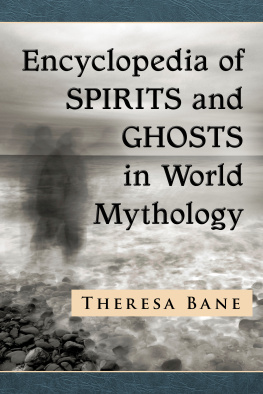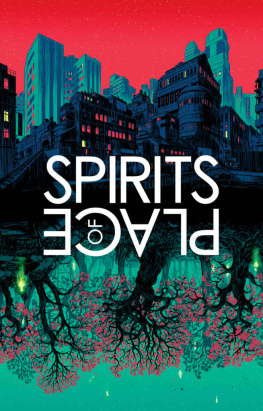RUY BLANES is a postdoctoral research fellow at the University of Bergen and associate researcher at the Institute of Social Sciences in Lisbon. He is coeditor of Encounters of Body and Soul in Contemporary Religious Practices: Anthropological Reflections. DIANA ESPRITO SANTO is a postdoctoral research fellow at the Research Center in Anthropology at the New University of Lisbon.
The University of Chicago Press, Chicago 60637
The University of Chicago Press, Ltd., London
2014 by The University of Chicago
All rights reserved. Published 2014.
Printed in the United States of America
23 22 21 20 19 18 17 16 15 14 1 2 3 4 5
ISBN -13: 978-0-226-08163-2 (cloth)
ISBN -13: 978-0-226-08177-9 (paper)
ISBN -13: 978-0-226-08180-9 (e-book)
DOI : 10.7208/chicago/9780226081809.001.0001
Library of Congress Cataloging-in-Publication Data
The social life of spirits / edited by Ruy Blanes and Diana Esprito Santo.
pages cm
Includes bibliographical references and index.
ISBN -13: 978-0-226-08163-2 (cloth : alk. paper) ISBN -10: 978-0-226-08177-9 (pbk. : alk. paper) ISBN -10: 978-0-226-08180-9 (e-book) 1. SpiritsSocial aspects. 2. Carribean AreaReligion. 3. Afro-Brazilian cults. I. Blanes, Ruy Llera, 1976II. Esprito Santo, Diana.
BL477.S65 2014
20'.109729dc23
2013015003

This paper meets the requirements of ANSI/NISO z39.48-1992 (Permanence of Paper).
Introduction
On the Agency of Intangibles
Diana Esprito Santo and Ruy Blanes
Just cause you feel it doesnt mean its thereThere There, Radiohead, 2003
We cannot be too sure what Thom Yorke, the singer and lyricist behind Radiohead, the alternative musical act from Oxford, was thinking when he wrote the song There There. The line from the epigraph, which is a verse from the song There There, could be a reversion of a radically empiricist stance (I only believe what I see), but it could also be an expression of self-doubt regarding the reliability of our own senses and perceptions (Should I believe in what I feel?). Or both. In any case, it brings to mind the notion of perceptive faiths (Merleau-Ponty 1968, 17) and of how to understand and integrate perceptive and sensorial alterity in the practice of anthropology and other humanities disciplines. The reliability of the senses, as we know, is a notoriously tricky issue. But we dont have to rely on them to be able to conjure up an assortment of entities whose existence we routinely take for grantedculture being one familiar to the anthropologistbut that are as empirically invisible as ghosts.
This book, which explores different conceptualizations of an agency of intangibles, sets out to unravel the contingency of various entities on their effects. This exploration rests upon a philosophical and epistemological assumption, which is also a challenge: the recognition of the anthropological relevance of the mechanics and effects of so-called invisible or intangible domains, whether these are constituted by spirits, quarks, the law, or money value.
This, in many ways, has been part of anthropological inquiry since its inception. Below we explore stories of nineteenth-century concerns with the invisible, which we are heirs to. We could also understand the long-standing interest in spirit possession as one such interrogation. Moving beyond psychological, neurophysiological, metaphysical, and representational accounts of possession, anthropologists have long sought to understand and explain, both emically and etically, contacts, manifestations, and mediations (or mediumships) with the otherworldly, and the regimes of proof and evidence that underlie them (Lambek 1981; Lewis [1971] 2003). In this line of thought, one frequent materialization of spirit possession effects has been located in bodily or embodied practices. Through the body, as Janice Boddy (1989) suggests, we uncover meaning and context, idiom and ideology. This volume inherits these classic attempts to unveil cultural context, while seeking to explore the alien dimension of phenomena such as spirit possession: the categories of sovereignty and foreignness (Voss 2011) involved and the spiritual, ontological, and political consequences of such frontier making.
On the other hand, there is no anthropological exclusivity in charting the conditions of possibility of the invisible and its effects. Ioan Lewis describes, in his classic Ecstatic Religion, how a body of literature on the occult predicted trance becoming as easily accessible as electricity ([1971] 2003, 16). Ever since, scientists have studied and speculated over the invisible and intangible through their effects, conjuring up several assumptions regarding empirical evidence along the way (see Latour 1993b). From this perspective, astronomy, as the study and prediction of effects in the interface of empirical observation and theoretical speculation, has long been a discipline of limitsone that determines the frontier of the universe, our world, our knowledge, our understanding. Probably for that same reason, it has also been a discipline of systematization and organization, at least since Pierre-Simon Laplaces Exposition for a System of the World (1808), in which the renowned astronomer and mathematician sought to explain celestial mechanics through the apparent movement of celestial bodies, and identified the existence of black holes as phenomena so dense in gravity that they become un-observable.
If astronomy has its own black holes, in terms of explanatory theories and refutations that address limits, perceptions, quandaries, and so on, so does anthropology. By tracing the conditions by which such entities have effects, and by exploring crucial dimensions of definition and narrativization involved in processes of recognition and legitimationand thus, the sanctioning of their social lifewe aim, firstly, to sideline concerns with conceptual bounding and instead attend to the production of the indexicalities (Keane 2007) that allow them to come into being as objects, scientific (Daston 2000) or otherwise. Secondly, our aim is based on a critical reflection on the kinds of problems generated by an epistemology of the senses, both in terms of how we generally think through and about empiria, materiality, and evidence in our practices as anthropologists and persons and in terms of the scope of the senses as producers of knowledge. The assumption here is that entities can reside outside as well as inside this sensorial scope by virtue of the traces, symptoms, and effects they socially and materially engender.
This books proposal is both old and new. On the one hand, it follows from the commonsense notion that most of the things that affect us as human beings are invisible, disperse; we cannot touch them as we would objects or confine them to a particular essence, space, or time. It also drinks from the disciplines historical openness toward epistemologically challenging objects (Vasconcelos 2008). On the other hand, it follows from anthropologys urge to engage with extramaterial forms of sociality and practiceboth by coming to terms with the notion that people develop and live in worlds that are often radically different to each other, where they perceive and interact with different entities, and by engaging in the extension and revision of some anthropological concepts and methods to deal with these ontological differences, particularly those that see entities in a purely mental or conceptual sense. The aim of this introduction is to identify some of the problems and dividends associated with assuming (invisible, intangible) entities as objects of research.












 This paper meets the requirements of ANSI/NISO z39.48-1992 (Permanence of Paper).
This paper meets the requirements of ANSI/NISO z39.48-1992 (Permanence of Paper).